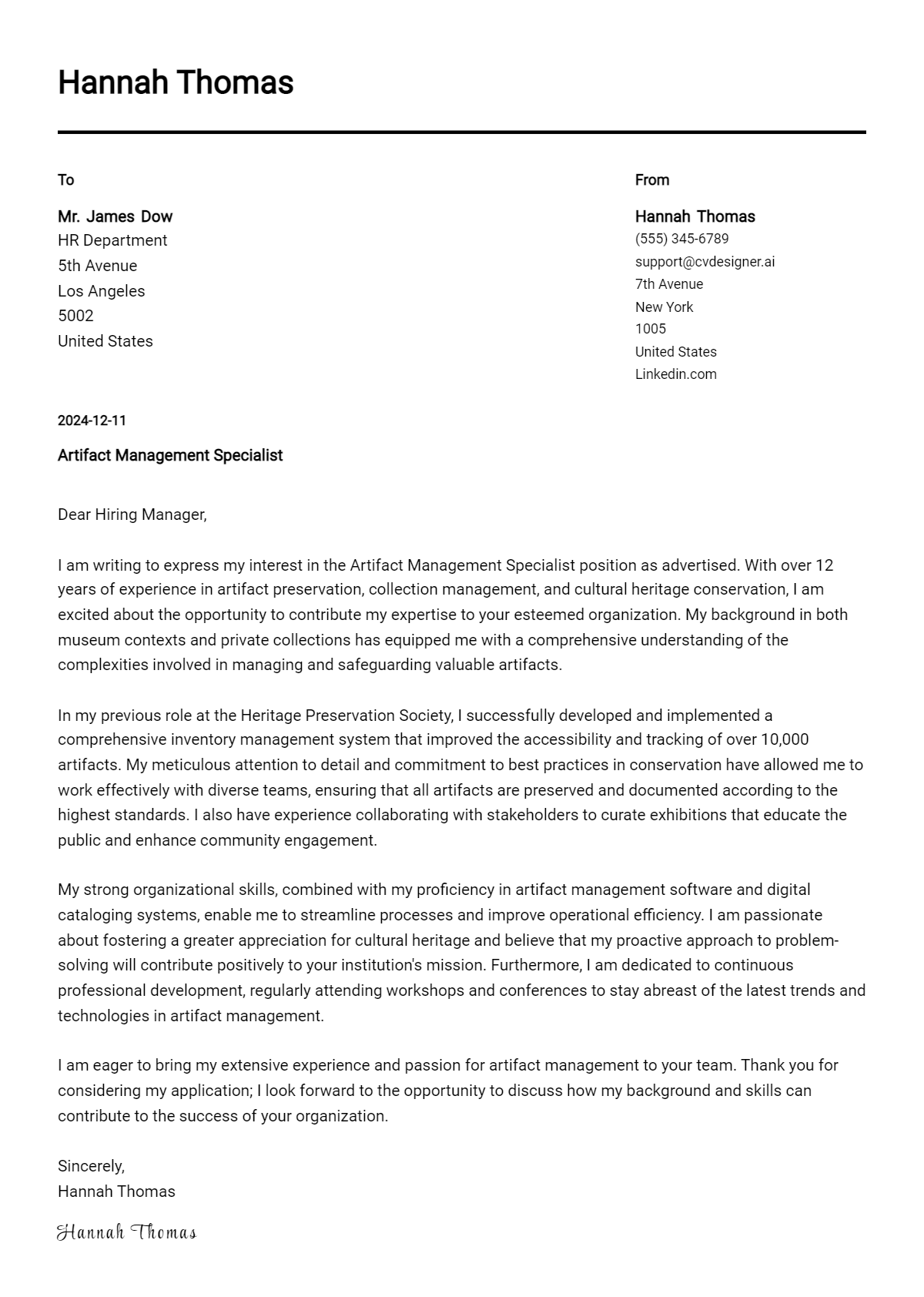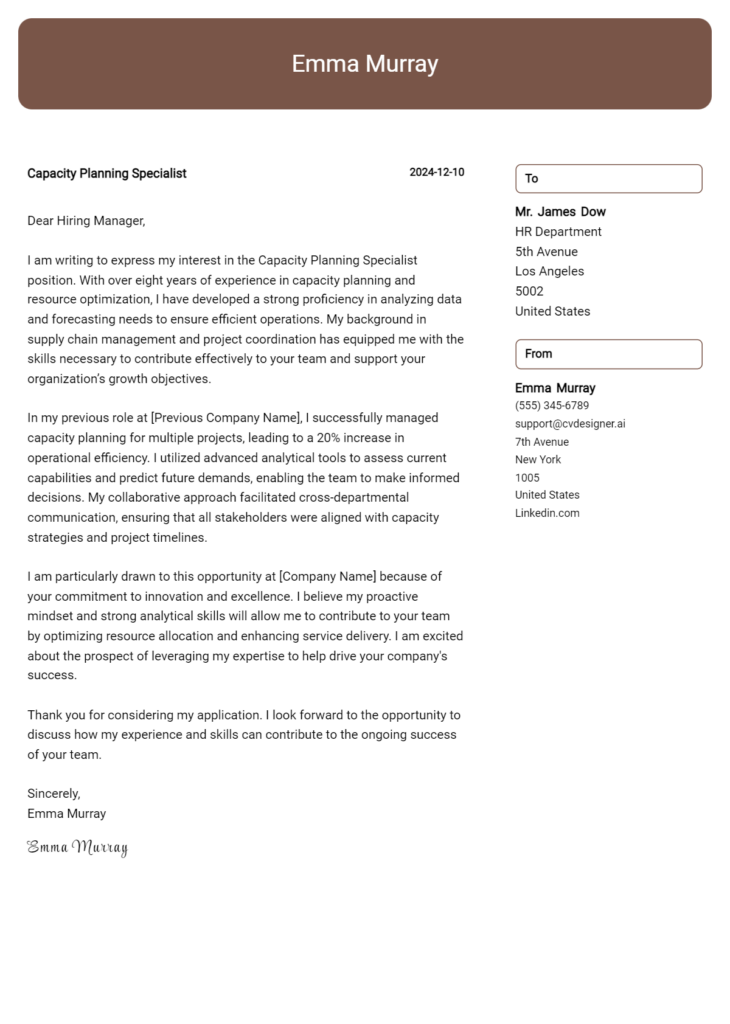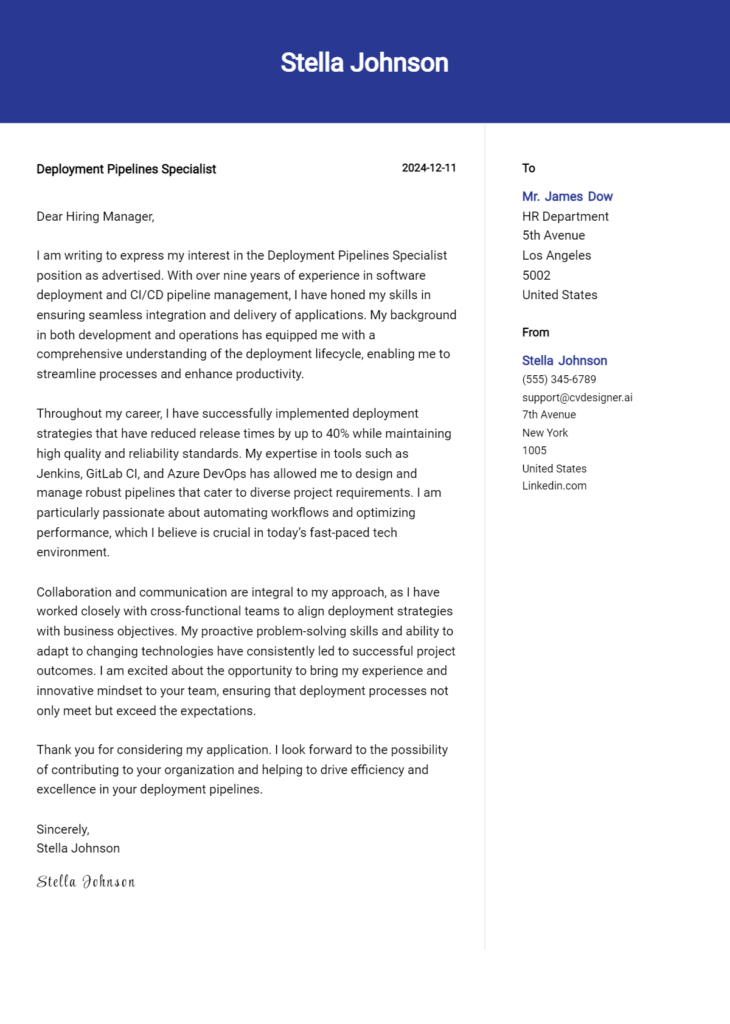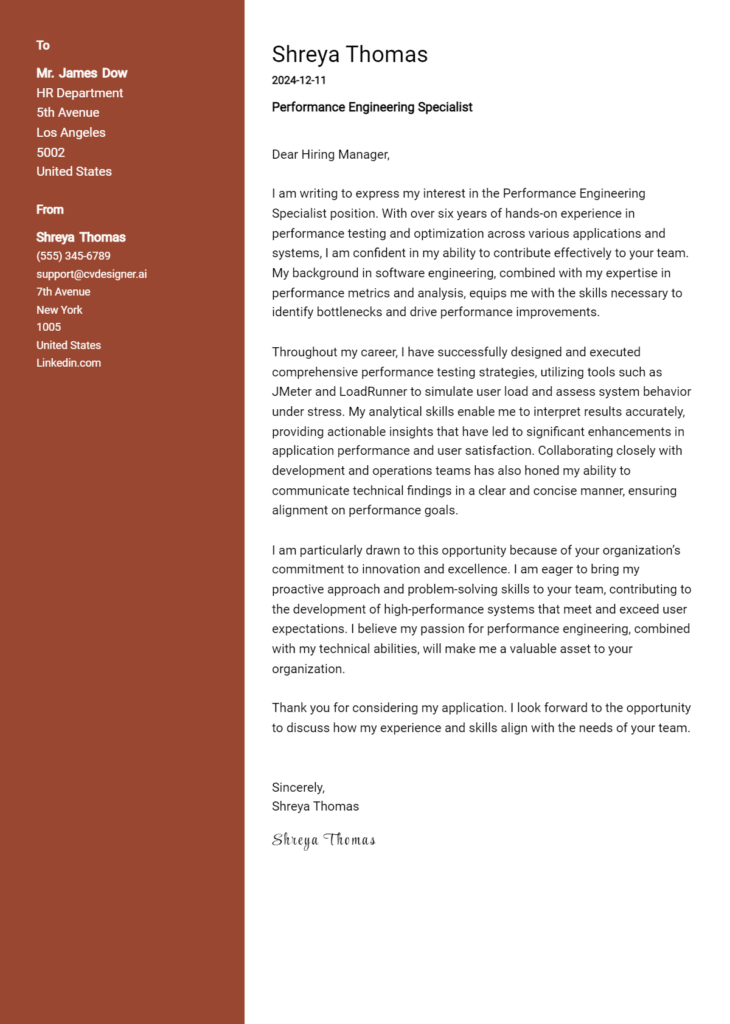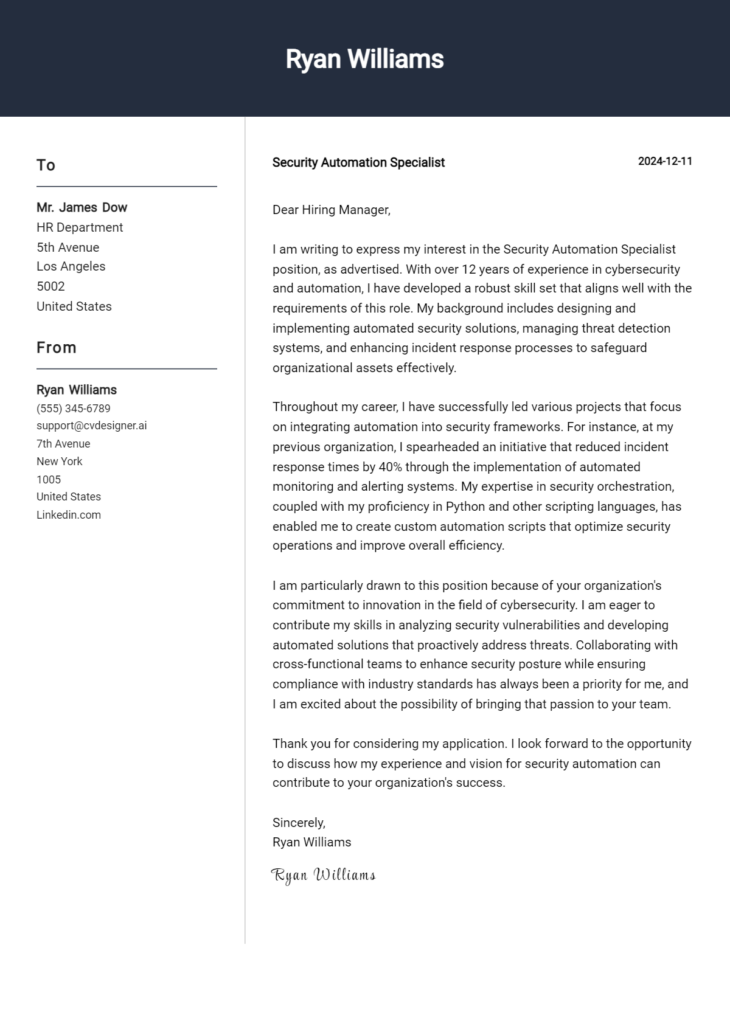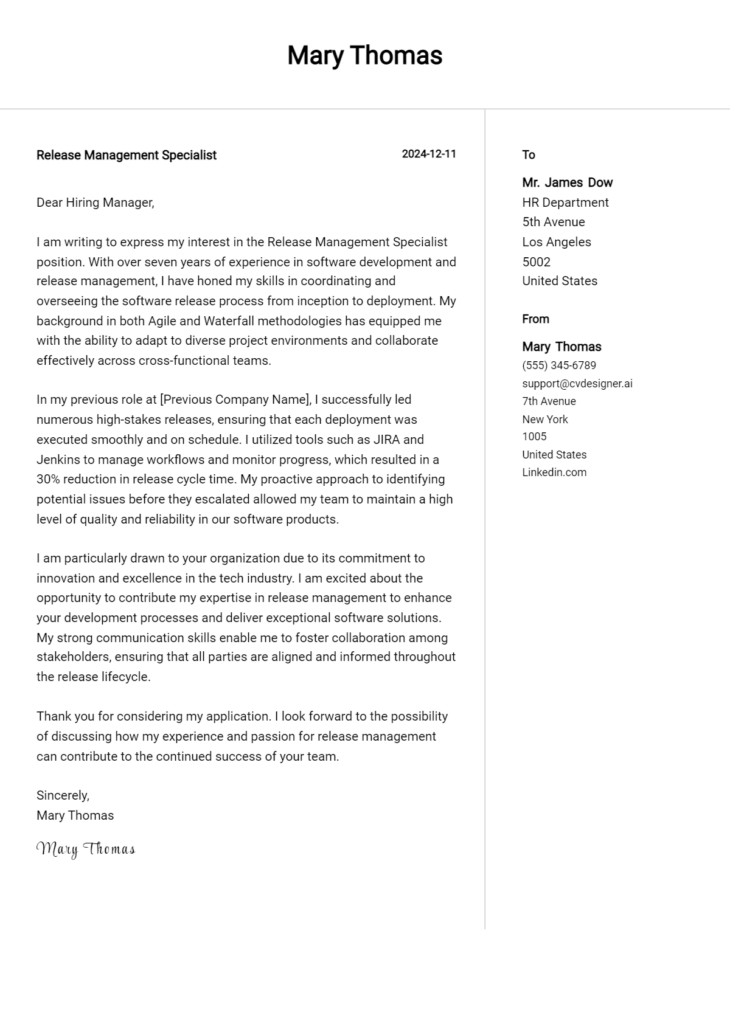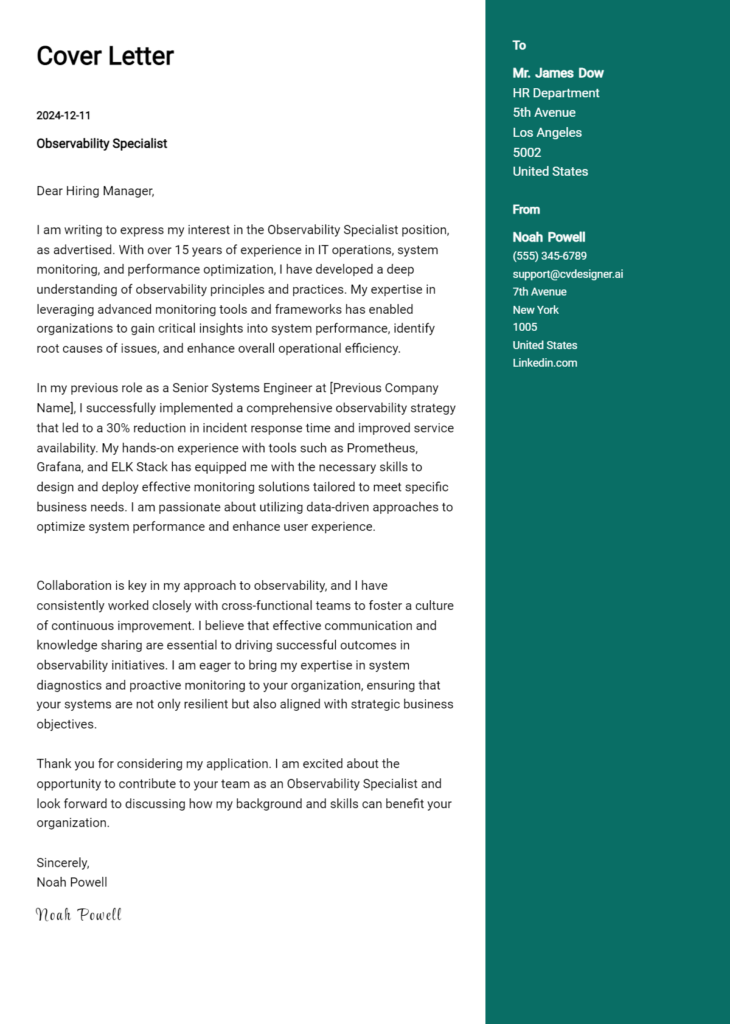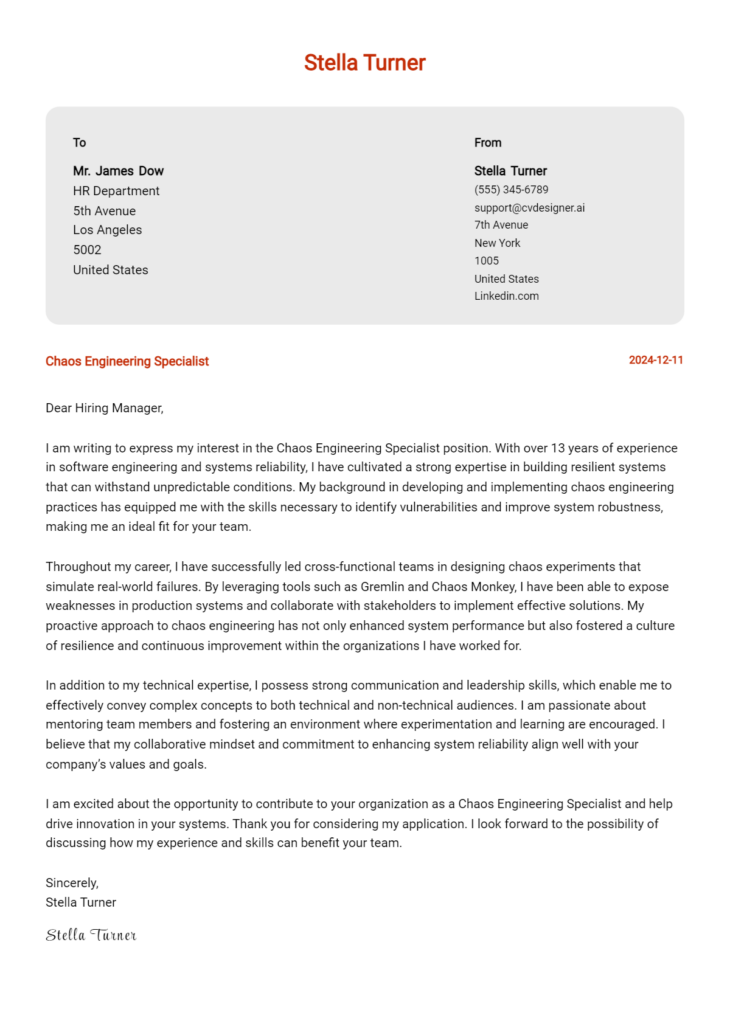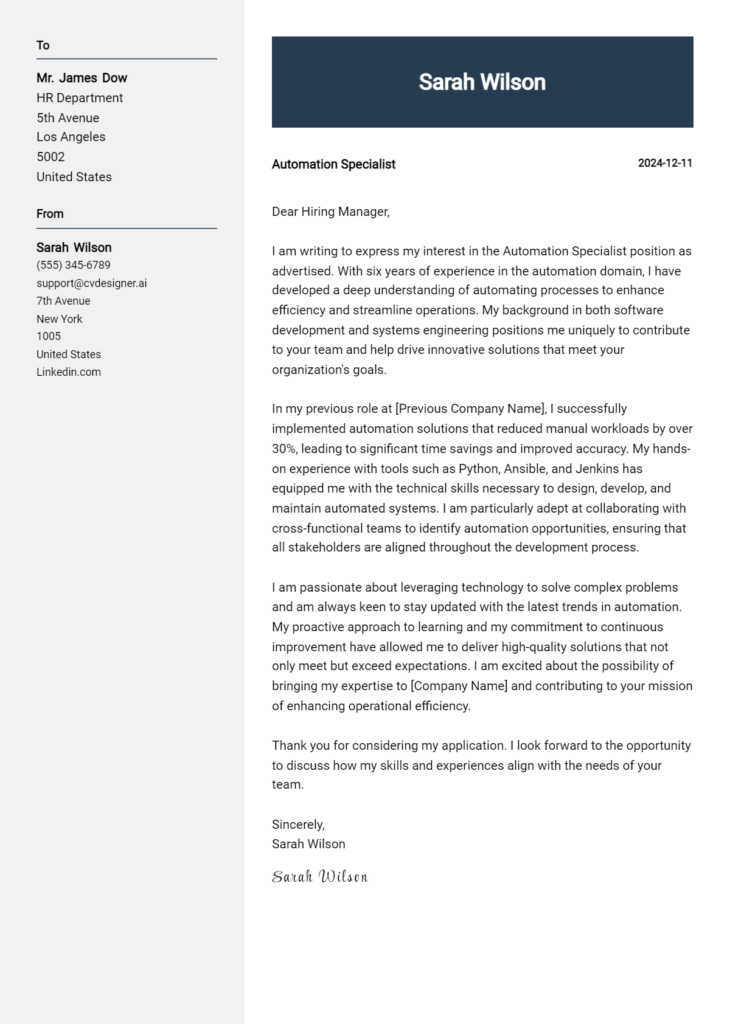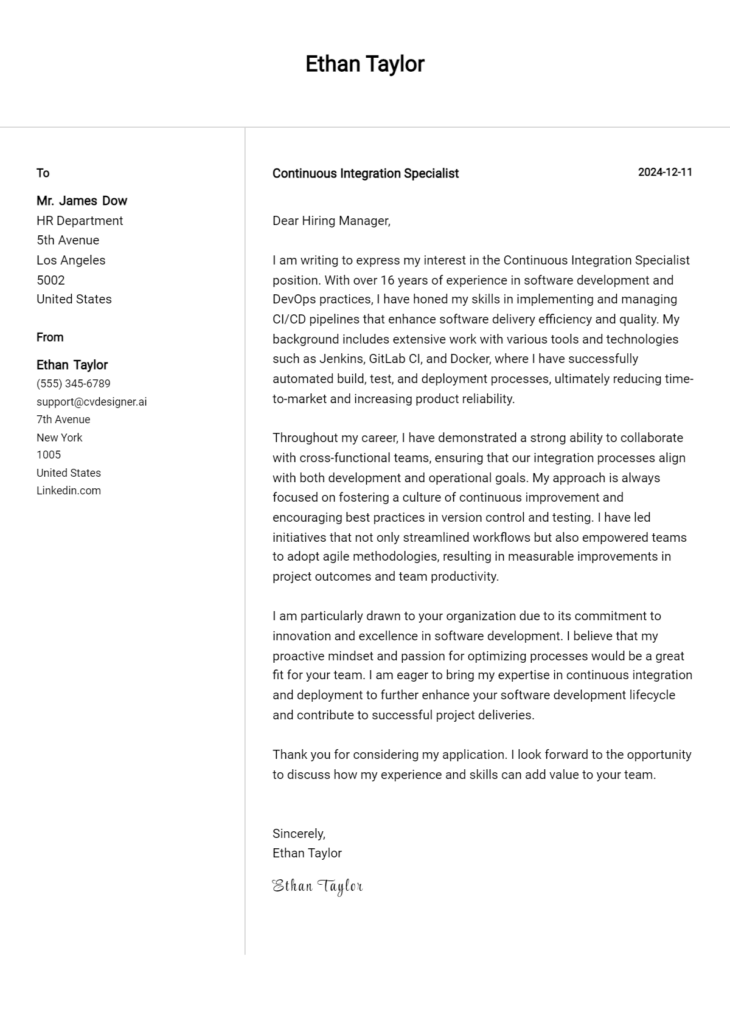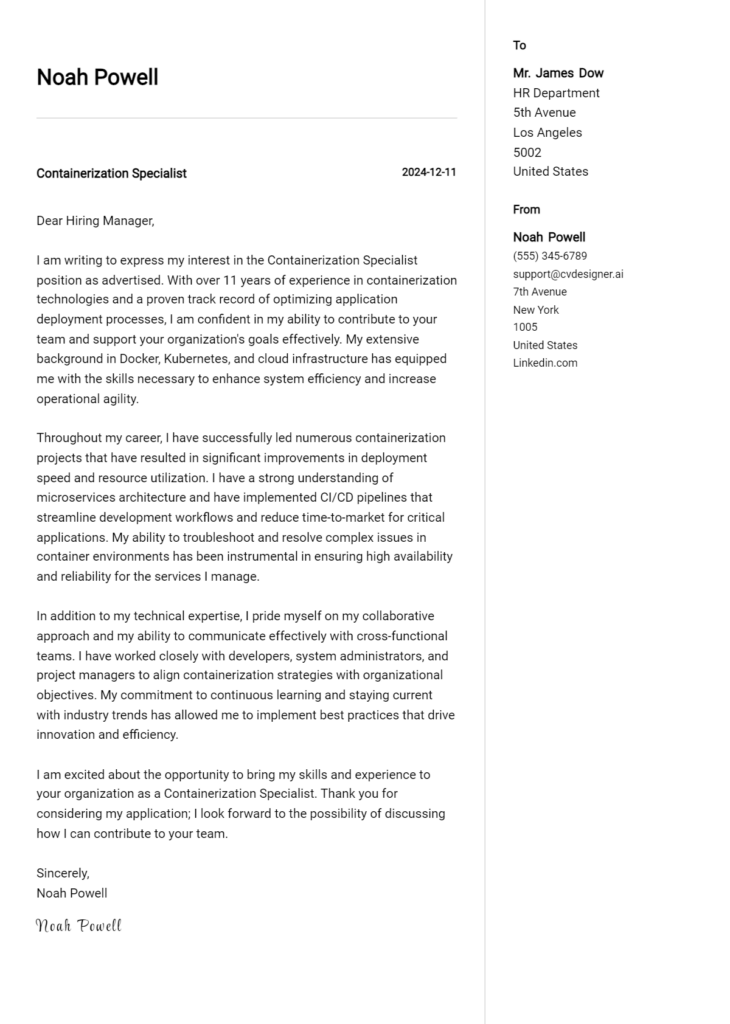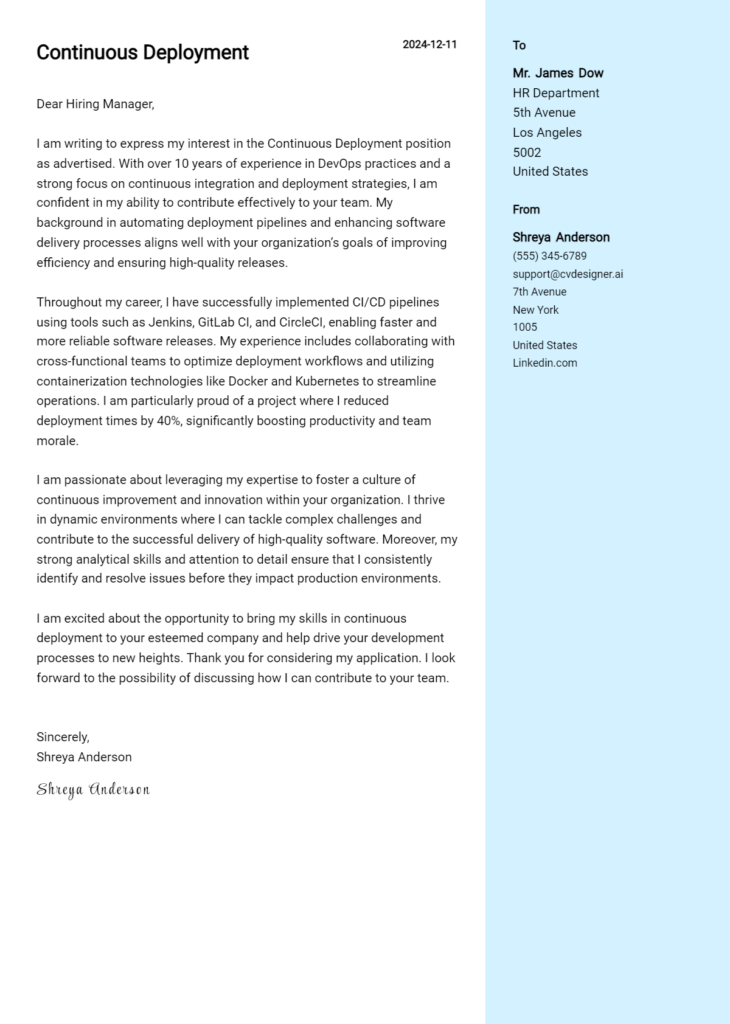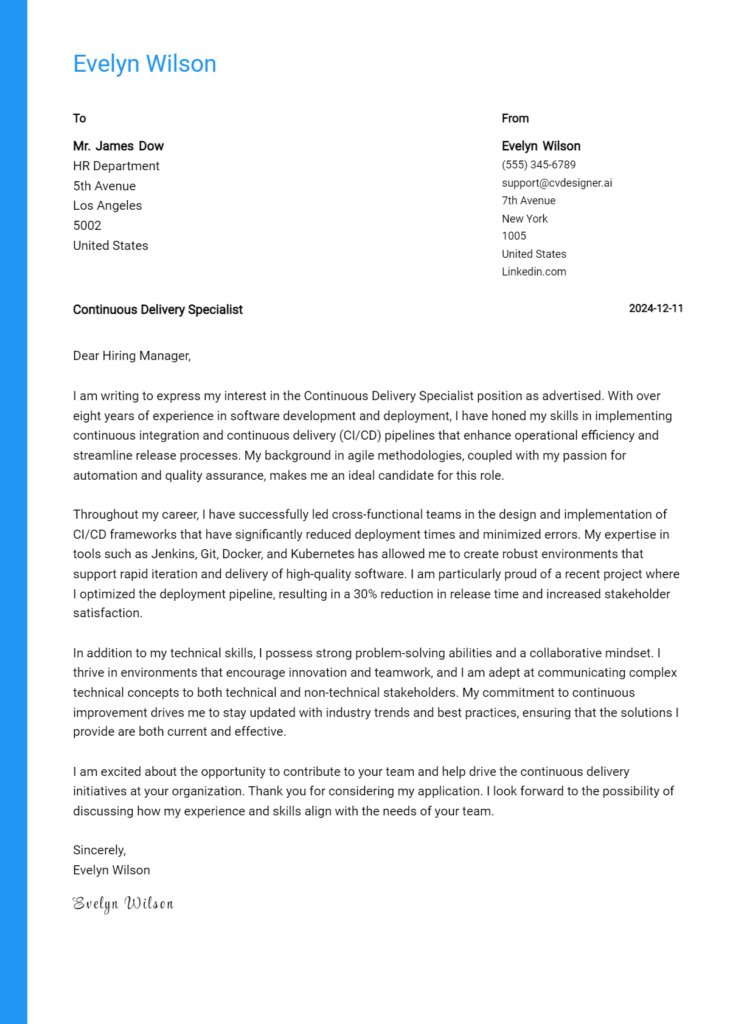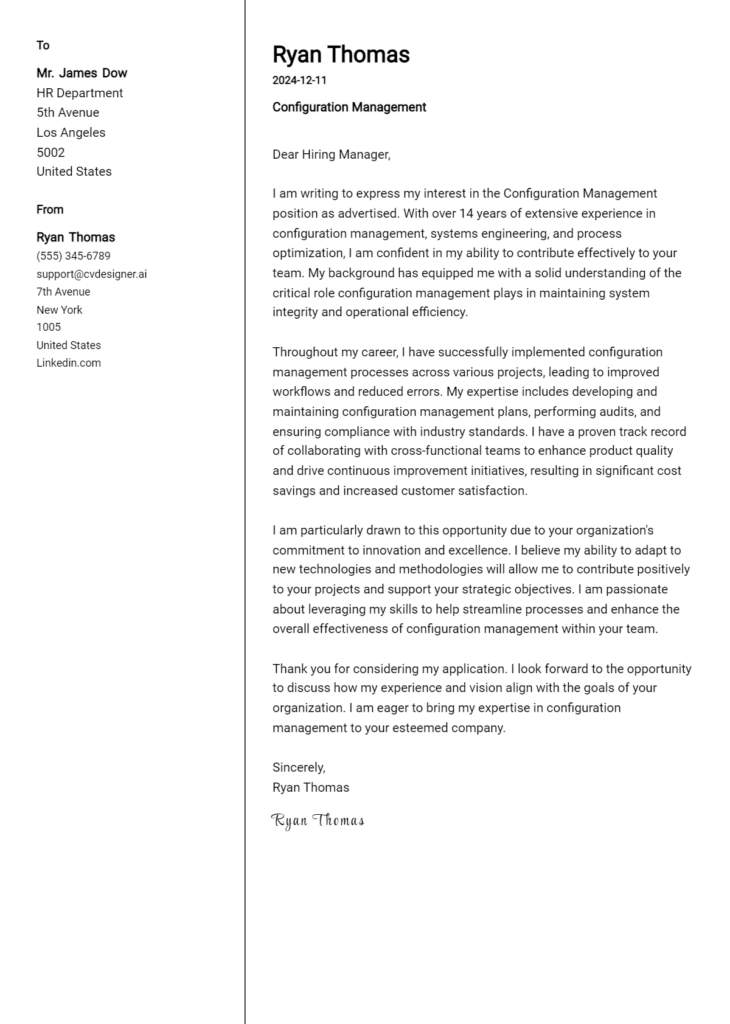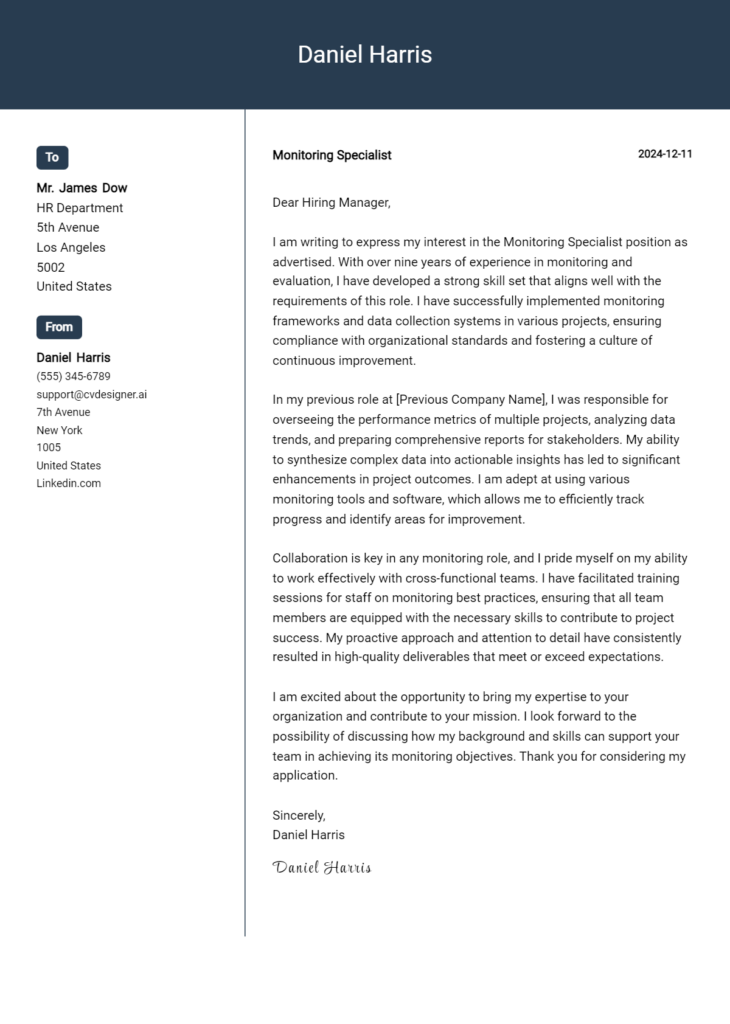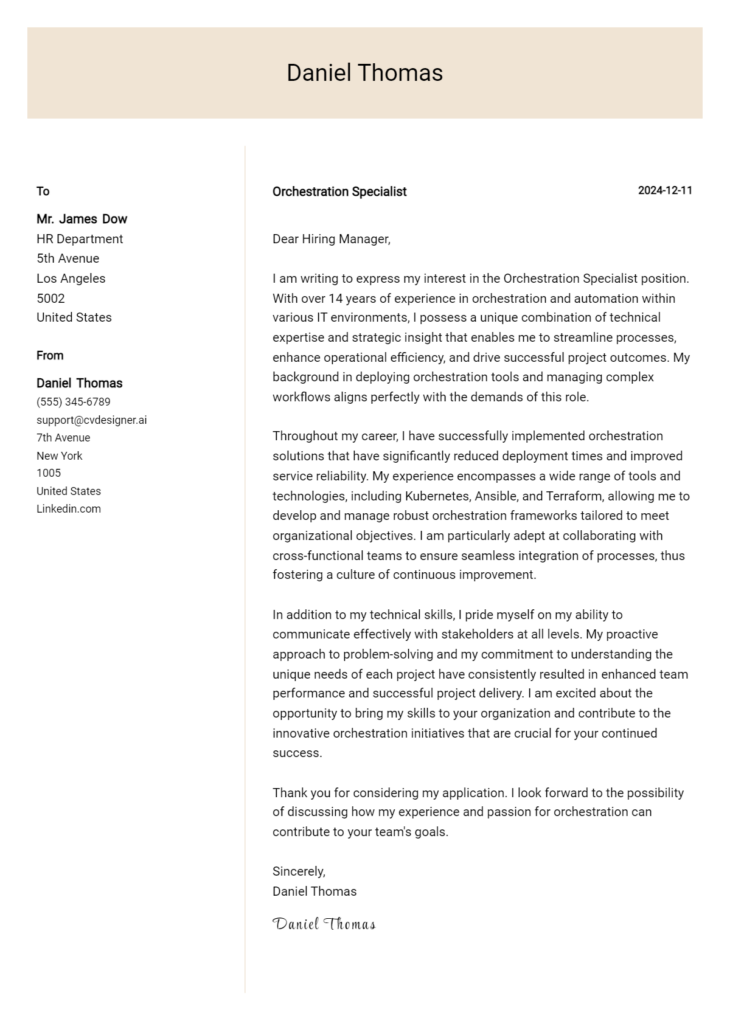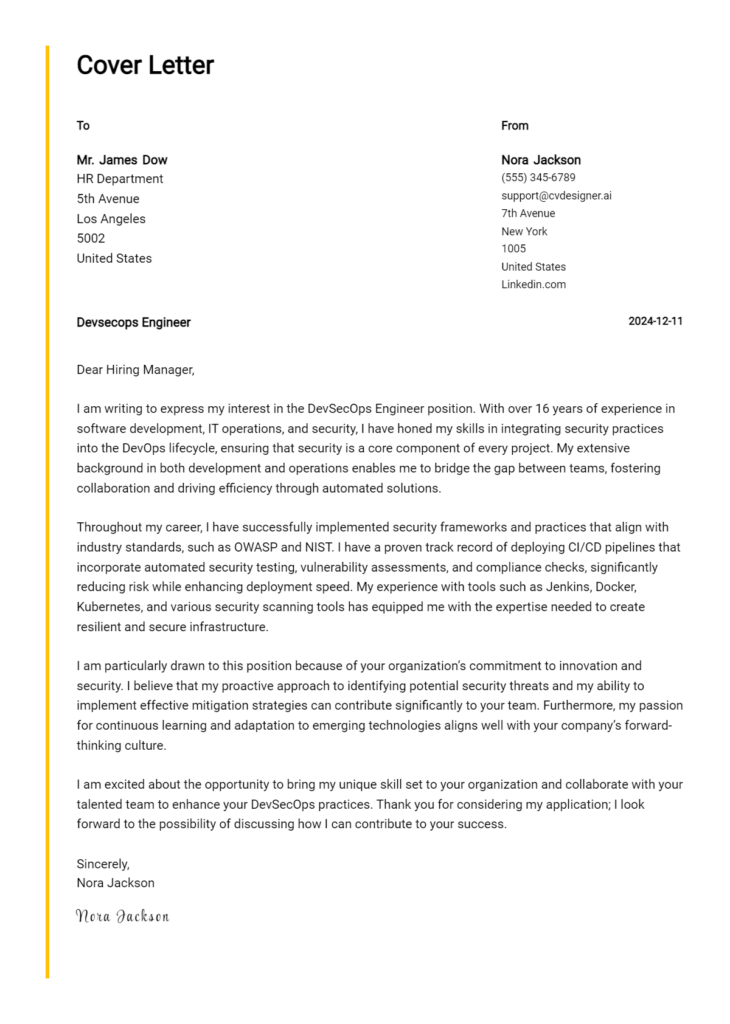Artifact Management Specialist Cover Letter Examples
Explore additional Artifact Management Specialist cover letter samples and guides and see what works for your level of experience or role.
How to Format an Artifact Management Specialist Cover Letter
Crafting a well-structured cover letter is essential for an Artifact Management Specialist, as it serves as your first impression to potential employers. The way you format your cover letter not only showcases your qualifications but also reflects your organizational skills and attention to detail—crucial traits in the field of artifact management. A meticulously crafted cover letter can effectively communicate your passion for preserving history and your ability to manage valuable collections, making it a vital tool in your job application process.
In this guide, we will explore how to format your cover letter, providing specific insights and examples tailored for the artifact management profession.
We will highlight the key components of a professional cover letter, including:
- Cover Letter Header
- Cover Letter Greeting
- Cover Letter Introduction
- Cover Letter Body
- Cover Letter Closing
Each section plays a significant role in presenting your qualifications and professionalism. Let’s delve into each part to help your cover letter stand out in the competitive field of artifact management.
Importance of the Cover Letter Header for an Artifact Management Specialist
The cover letter header is a crucial element for an Artifact Management Specialist, as it sets the tone for your application and presents your professionalism right from the outset. A well-structured header provides essential information, including your contact details, the date, and the recipient's information, ensuring clarity and facilitating communication. This section should be formatted neatly to create a strong first impression, reflecting your attention to detail—an important trait for someone in artifact management.
Here are examples of a strong and weak cover letter header:
Strong Example
Jane Doe 123 Artifact Lane Museum City, ST 12345 jane.doe@email.com (123) 456-7890 October 1, 2023 Mr. John Smith Hiring Manager Cultural Preservation Organization 456 Heritage Blvd Preservation City, ST 67890
Weak Example
jane doe email: jane.doe@email.com 10/1/23 To whom it may concern:
In the strong example, all relevant information is clearly presented and formatted, showcasing professionalism. In contrast, the weak example lacks proper capitalization, specific recipient details, and critical formatting, which could undermine the applicant's credibility.
The Importance of the Cover Letter Greeting
The greeting of a cover letter plays a crucial role in setting the tone for the rest of the letter. It serves as the first impression the hiring manager will have of you, demonstrating your professionalism and attention to detail. By addressing the hiring manager directly, you personalize your application, showing that you have taken the time to research the company and its personnel. Avoiding generic greetings, such as "To Whom It May Concern," can significantly enhance your cover letter's effectiveness. If the recipient's name is not readily available, a little research can go a long way, whether through the company website, LinkedIn, or other professional networks. A well-crafted greeting can create a positive impact, making the reader more inclined to continue reading.
Strong Greeting Example
Dear Ms. Johnson,
Weak Greeting Example
To Whom It May Concern,
Importance of a Strong Cover Letter Introduction for an Artifact Management Specialist
A well-crafted cover letter introduction is crucial for an Artifact Management Specialist as it sets the tone for the rest of the document and captures the hiring manager's attention. This initial paragraph should not only express the candidate’s enthusiasm for the role but also highlight relevant skills and achievements that align with the job requirements. A strong introduction can differentiate a candidate from others by immediately showcasing their fit for the position, while a weak introduction may fail to convey passion or relevant qualifications, leading to a missed opportunity.
Strong Example
Dear [Hiring Manager's Name], As a dedicated Artifact Management Specialist with over five years of experience in preserving and cataloging cultural heritage assets, I am excited to apply for the position at [Company Name]. My background in implementing innovative preservation techniques and my passion for safeguarding historical artifacts align perfectly with your organization’s mission to enrich community engagement through cultural preservation. I am eager to bring my expertise in digital archiving and project management to your esteemed team, making a significant impact on the preservation efforts at [Company Name].
Weak Example
Dear [Hiring Manager's Name], I am writing to apply for the Artifact Management Specialist position. I have some experience in this field and think it would be a good job for me. I have worked with artifacts before and have some skills. I hope you will consider my application.
Cover Letter Body for Artifact Management Specialist
The cover letter body for an Artifact Management Specialist is a crucial component that allows candidates to present their relevant skills and experiences, demonstrating their value to a potential employer. This section should detail specific projects or accomplishments that showcase the candidate's expertise in artifact management, such as successful implementation of inventory systems, contributions to preservation efforts, or experience in utilizing digital tools for artifact tracking. By providing concrete examples, candidates can effectively illustrate their problem-solving abilities, attention to detail, and commitment to preserving and managing artifacts, making a compelling case for their fit within the organization.
Strong Example
Dear [Hiring Manager's Name], I am excited to apply for the Artifact Management Specialist position at [Company Name]. In my previous role at [Previous Company], I successfully led a project to digitize a collection of over 5,000 historical artifacts, which not only enhanced our inventory management system but also improved public access to our collections. This project resulted in a 30% increase in visitor engagement and significantly reduced the time staff spent locating items. Additionally, my experience in collaborating with curators and conservators has equipped me with a deep understanding of best practices in artifact preservation and management, ensuring that I can contribute effectively to your team’s goals. Sincerely, [Your Name]
Weak Example
Dear [Hiring Manager's Name], I am writing to apply for the Artifact Management Specialist position. I have worked in museums and have some experience with artifacts. I believe I can help with the management of items at [Company Name]. I once helped organize a collection, which was nice. I am detail-oriented and work well with others, so I think I would be a good fit. Best, [Your Name]
Importance of the Cover Letter Closing for an Artifact Management Specialist
The closing paragraph of a cover letter is crucial as it serves to reinforce the applicant's qualifications, express enthusiasm for the role, and prompt the hiring manager to take the next steps, such as reviewing the resume or scheduling an interview. A strong closing can leave a lasting impression and motivate the employer to consider the applicant seriously, while a weak closing may undermine the overall effectiveness of the cover letter.
Strong Example
Thank you for considering my application for the Artifact Management Specialist position. With my extensive background in artifact preservation and collections management, along with my passion for cultural heritage, I am excited about the opportunity to contribute to your team. I look forward to the possibility of discussing how my skills can align with your organization's goals. Please feel free to reach out to schedule an interview or to review my resume for further details. Thank you again for your time and consideration.
Weak Example
I hope you like my application. I think I have some good experience. Let me know if you want to talk. Thanks.
Crafting a compelling cover letter is essential for candidates applying for the role of an Artifact Management Specialist. This document serves as your chance to showcase your unique qualifications and enthusiasm for the position. Emphasizing your technical skills, problem-solving abilities, knowledge of the Software Development Life Cycle (SDLC), teamwork capabilities, and a commitment to continuous learning can significantly enhance your application. Below are five detailed tips to help you create an effective cover letter that stands out to potential employers.
Tips for Writing a Cover Letter for Artifact Management Specialist
Highlight Technical Skills
Clearly outline your technical skills relevant to artifact management, such as familiarity with version control systems, build automation tools, and dependency management. Use specific examples to demonstrate how you've successfully utilized these skills in previous roles. Tailoring this section to match the job description can significantly increase your chances of catching the hiring manager's attention.Showcase Problem-Solving Abilities
Employers value candidates who can identify issues and implement effective solutions. Provide examples of challenges you've faced in artifact management and describe how you approached them. Whether it was streamlining processes or resolving conflicts in artifact dependencies, showcasing your analytical thinking will illustrate your capability to handle complex situations.Demonstrate SDLC Knowledge
Articulate your understanding of the Software Development Life Cycle and how it relates to artifact management. Mention any experience you have in different SDLC phases and how you’ve contributed to effective artifact tracking and management during these phases. This knowledge is crucial for ensuring a smooth workflow within development teams.Emphasize Teamwork and Collaboration
Artifact Management Specialists often work closely with various teams. Illustrate your ability to collaborate effectively by sharing experiences of successful teamwork. Highlight any roles you’ve played in cross-functional teams, emphasizing your communication skills and how you contribute to a positive team dynamic.Express a Passion for Continuous Learning
The tech landscape is ever-evolving, making continuous learning vital in this field. Share your commitment to professional development, whether through certifications, workshops, or online courses. Discuss how staying updated with the latest trends in artifact management has benefited your previous roles and how you plan to continue this trajectory.
By incorporating these tips into your cover letter, you can create a strong narrative that resonates with employers. For further assistance, consider utilizing cover letter templates or a cover letter builder to streamline the process and ensure your letter is polished and professional.
Common Mistakes to Avoid in a Artifact Management Specialist Cover Letter
Crafting a compelling cover letter is essential for standing out as an Artifact Management Specialist. Avoiding common mistakes can significantly enhance your chances of success. Here are some frequent pitfalls and tips on how to steer clear of them:
Generic Content: Many applicants use a one-size-fits-all approach. Tailor your letter specifically for the Artifact Management Specialist role by highlighting relevant experiences and skills.
Neglecting Formatting: An unorganized cover letter can detract from your message. Follow a clear cover letter format that includes a professional header, a concise introduction, and well-structured body paragraphs.
Focusing on Responsibilities Instead of Achievements: Instead of listing job duties, emphasize your accomplishments. Use quantifiable results to demonstrate your impact in previous roles.
Failure to Research: Not knowing the organization or its mission can result in a disconnected cover letter. Conduct thorough research on the company and incorporate relevant insights into your writing.
Overlooking Proofreading: Typos and grammatical errors can undermine your professionalism. Always proofread your cover letter multiple times or enlist a friend to review it.
Ignoring the Call to Action: Failing to express enthusiasm for following up can leave your letter feeling incomplete. Conclude with a strong call to action, inviting the employer to discuss your application further.
Being Too Formal or Casual: Striking the right tone is crucial. Aim for a balance between professionalism and approachability, ensuring your personality shines through without sacrificing formality.
For more guidance, consider reviewing cover letter examples that align with your target role.
Build your Cover Letter in minutes
Use an AI-powered cover letter builder and have your letter done in 5 minutes. Just select your template and our software will guide you through the process.

